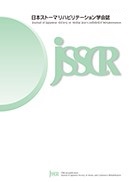Volume 10, Issue 1
Total21
Displaying 1-16 of 16 articles from this issue
- |<
- <
- 1
- >
- >|
-
1994Volume 10Issue 1 Pages 0
Published: 1994
Released on J-STAGE: February 29, 2024
Download PDF (969K)
-
1994Volume 10Issue 1 Pages 1-5
Published: 1994
Released on J-STAGE: February 29, 2024
Download PDF (2325K) -
1994Volume 10Issue 1 Pages 7-16
Published: 1994
Released on J-STAGE: February 29, 2024
Download PDF (4953K) -
1994Volume 10Issue 1 Pages 17-24
Published: 1994
Released on J-STAGE: February 29, 2024
Download PDF (4695K) -
1994Volume 10Issue 1 Pages 25-34
Published: 1994
Released on J-STAGE: February 29, 2024
Download PDF (5665K) -
1994Volume 10Issue 1 Pages 35-41
Published: 1994
Released on J-STAGE: February 29, 2024
Download PDF (4051K) -
1994Volume 10Issue 1 Pages 43-47
Published: 1994
Released on J-STAGE: February 29, 2024
Download PDF (2419K) -
1994Volume 10Issue 1 Pages 49-54
Published: 1994
Released on J-STAGE: February 29, 2024
Download PDF (3548K) -
1994Volume 10Issue 1 Pages 55-58
Published: 1994
Released on J-STAGE: February 29, 2024
Download PDF (2212K) -
1994Volume 10Issue 1 Pages 59-65
Published: 1994
Released on J-STAGE: February 29, 2024
Download PDF (3303K) -
1994Volume 10Issue 1 Pages 67-72
Published: 1994
Released on J-STAGE: February 29, 2024
Download PDF (3306K)
-
1994Volume 10Issue 1 Pages 73-76
Published: 1994
Released on J-STAGE: February 29, 2024
Download PDF (2398K) -
1994Volume 10Issue 1 Pages 76-79
Published: 1994
Released on J-STAGE: February 29, 2024
Download PDF (2186K) -
1994Volume 10Issue 1 Pages 80-82
Published: 1994
Released on J-STAGE: February 29, 2024
Download PDF (1603K) -
1994Volume 10Issue 1 Pages 83-86
Published: 1994
Released on J-STAGE: February 29, 2024
Download PDF (2543K) -
1994Volume 10Issue 1 Pages 87-91
Published: 1994
Released on J-STAGE: February 29, 2024
Download PDF (3141K)
- |<
- <
- 1
- >
- >|
